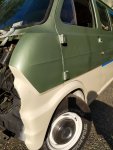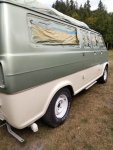Myvanisbetter
Observer
Where is this awesome rig in WA? Can't wait to hopefully see it cruising around!
...Yeah, I already used the leftover allthread I had from making new brake linkages to make a press...
Where is this awesome rig in WA? Can't wait to hopefully see it cruising around!
Allthread is generally ungraded chinesium garbage. No way I would use it for brake linkage without grossly oversizing it and reinforcing it with sleeves.
...and the next smallest length is 3". So to add a bit more length (it should be right at 5" overall length) I got some 5/16" threaded rod. Between the clevis on one end, the heim joint on the other, and the jam nuts there is maybe 1/4" of exposed threaded rod. I will keep an eye on it but so far I have a feeling that it will hold up from bending pretty well.
I live in Burien, but currently the van is stored in Carbonado (If you dont know it, its a town of 600 people right next to rainier. Its where I grew up)
As for seeing it cruising around, during the winter you will see it out on the Skagit or the OP chasing steelhead. During the summer it will be all over the state chasing trout on tiny blue lines, with a few excursions to some bigger rivers if they are fishing good. I might make it to a few overland events in Washington next year just for fun.
I live about 20 min from there! Spent many a night up the logging roads at the end of town!

Paint looks great as is! Can't wait to see it all done for sure!!! Do you have a front chrome grill for it?


...Im wokring on planning something out that will help the engine breathe better (also helps with mpg on older 302's) but not cause a huge amount of in cabin noise. Im also debating back and forth on going with headers, and possible a dual plane intake manifold to add a bit more power (The doorjam tag states it was rated for 148hp to the wheels from the factory)
Never seen a to-the-wheels hp number from Ford in this era. That's probably a gross hp rating, being pre-72 and would be just the engine on a dyno, no accessories, unlike the post-72 net hp figures.
The factory intake is already a dual-plane manifold.
Headers are louder than manifolds inside the cabin.
A single 2-1/2" exhaust will support your engine's full potential, even upto 225hp so long as the bends aren't anything way out of the ordinary. There's a great new video on muffler comparisons on MotorTrend On-Demand's Engine Masters show.
You would only want "full advance at 65-70" under high vacuum (low load). Advanced timing while climbing a grade on the highway is a terrible idea. Advance is increased by rpm and vacuum, not mph, nor even relative to mph. #eyeroll
You're not going to get enough additional power from that drivetrain to matter much but consider this, if it could climb the hills and drive cross-country in 1969, it could do it today. Just needs to be maintained to its original standards. If you want it to do more or do it faster than in 69, you should consider the whole package. More power needs more cooling. Higher speeds need better brakes. And so on and so on.
In a totally stock but well-tuned v8 Ford van loaded to the gills, you'll pass semis, VWs, RVs and boats going up the hills. That should be plenty.
Initial advance is set by rotating the distributor in the engine, not on a distributor machine. The number of fan blades has less impact on how much air is moved than the pitch of the blades. The transmission will be unhappy in cold weather without the radiator's in-tank transmission loop.
Good luck with this cool and interesting build. Enjoying this thread!
